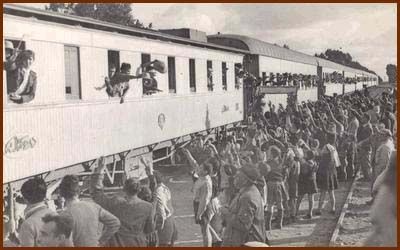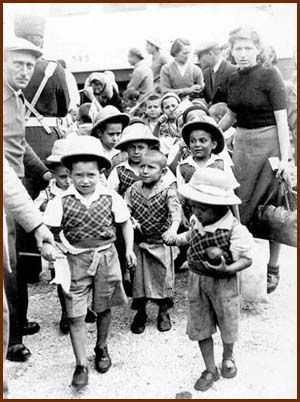 |
 |
|
|
|
The end of Grynberg's has the original list of those who arrived on February 18th, 1943, those who arrived on August 1943, and those who gave the testimonies. I knew immediately that I would translate and process these lists and post in JewishGen, as part of their Holocaust database, as an integral part of the survivors' database, in addition to the Pinkas Hanitzolim (Register of Survivors) already computerized. The aim is to find the relatives they have never known, as they were so little when the cruel circumstances of the war separated them from their family, their roots, and their past. The list contains the year of birth of the child, the parents in many cases, and the town of birth in Poland. I translated it and then found the original typed list in English in another book about the Tehran Children (in Hebrew): Gadith Shamir: “The Tehran Children” Since the Eruption of Second World War, Published by the Public Commission to Commemorate the “Tehran Children” by Meir Ohad, Tel Aviv 1989. There I found the original list (but only those who arrived on February 18th, 1943), which was translated into Hebrew in Grynberg's book. I matched my entries to this list.
Re-checking the data was like inserting the information for the second time. Then Mr. Henryk Greenberg proofread the list and my sincere thanks to him for his kind cooperation with JewishGen and me. I thank also Yad Vashem which approved the project. My thanks also to Eva Floersheim, author of the moving web site about Holocaust children searching their identity (“Missing Identity”), who also proofread the list.
The escape of the children from Poland saved them from the clutches of the Nazi extermination machine, yet exposed them to cruel fate of helpless refugees, fighting all sorts of hardship: diseases of many kinds, incomprehensible hunger, cold, forced labor and confinement to an orphanage. These events are less documented in history books, and in this respect the “Children of Zion” contributes, through the testimonies of the individual child, to the general review of history.
The “Tehran Children” escaped from Poland to Russia after Germany conquered it in September 1939, or lived in regions annexed to the Soviet Union following the Molotov-Ribbentrop Pact of August 1939 (see Appendix I), which divided Poland between the two powers. Some of the children's original Polish towns moved from German hands to Russian and via versa (see Appendix II) during the period in which the Jews ran away, fleeing eastward from certain death, as history proved later. There were around 300,000 such refugees, according to some estimates. (See Note 2)
In the beginning of 1940 the Soviet authorities, through the NKWD, began mass expulsion of Polish citizens to gulags in Siberia. Many hundreds of thousands of Polish citizens, many Jews among them, were expelled to the depth of Russian Siberia. After weeks of a horrible journey in cattle cars, the deportees were settled in Siberia and lived under harsh and difficult conditions. The mortality rate was very high; many of the children died or became orphans in this period.
On June 22nd, 1941, Nazi Germany attacked the U.S.S.R. despite the non-aggression pact between them and a new era started for the Polish refugees, Jews among them. An amnesty was declared; as a result all the Polish citizens were set free from the gulags (see Appendix III). A mass emigration started, towards the Asian territories, mainly Uzbekistan, Tajikistan, Kyrgyzstan, Kazakhstan, and Turkmenistan.
A wave of hungry and sick refugees, wearing torn rags, flooded the towns of Tashkent, Samarqand, and others. Many of the children lost their parents in this period and many of the children themselves died of hunger and epidemics.
At the same time, General Wladyslaw Andres was freed from prison in Moscow and founded the Polish Armies in Exile, which would attack Germany in Italy, passing through the Middle East. The Soviet authorities agreed to the emigration of about 24,000 Polish citizens with the Andres army, including around 1000 Jewish children, most of them orphans, and 800 Jewish adults.
By the end of 1941, Sikorski, the prime minister of the Polish Government-in-Exile, managed to convince Stalin to send around 25,000 Polish soldiers of the Andres Armies to Iran, to arm themelves and to strengthen the British armies in the Middle East. Thirty-three thousand soldiers left, 11,000 citizens with them, including 3,000 children, of which about 1,000 were orphaned Jewish children. The “Tehran Children” left in trains from Samarqand to Krasnovodsk, and from there, through the Caspian Sea to Pahlevi, an Iranian port town on the Caspian eastern shores. From there they moved to Tehran.
In Pahlevi, refugee tent camps were immediately erected. The Jewish children suffered from heat, starvation, sicknesses, and also the abuses by their fellow Poles. The situation changed once the Jewish Agency learned about the refugees' camps and opened its Eretz Israel Office in Tehran. Messengers and instructors were sent to the camp; as a result, living conditions improved significantly. It is worth mentioning that Tzipora Sharet, a leader from the Yishuv in Eretz Israel, contributed to the children's welfare. David Lauberg (Laor), one of the adult refugees, was appointed to be the head of the camp. In 1995, David Laor submitted many documents, photographs and items to Yad Vashem. This material was the basis for another book about the “Tehran Children” published by Yad Vashem (Hebrew) “I Did not Have Time to be Sad,” 1996 (the story of Kaner Majloch from Pruchnik , a symbol of the children's odyssey).
In January 1943, the evacuation of the tent-city began. The children moved to Afhaz and then to the Iranian port of Bender Shapur, where they embarked on the S.S. Dunera, headed to Karachi. This route was chosen since the Iraqis refused to grant them transit visa through Iraq. From Karachi they embarked on another ship, the Neurolia, which sailed to Suez, Egypt. Then they crossed the Sinai Desert by train, were quarantined in El Arish for another two days, and finally after an odyssey of four years of agony, they arrived home and disembarked the train in Atlit in Eretz Israel (“Palestine” at that time), on February 18th, 1943.
The second group of (around 110 children) arrived via Iraq after the British suppressed the Rashid Ali's revolt that year.
The small Yishuv (the name of the Jewish settlement in Eretz Israel prior to the foundation of the State of Israel) rejoiced and welcomed the little children as if a miracle had happened. The children were distributed among Kibbutzim, Moshavim, and various educational institutions. Natan N. Alterman, the famous Hebrew poet, wrote a poem which is well known about the Tehran Children, “who also after they will grow old, will always remain “the Tehran Children”…
|
…“ yes, the war of the elders of Tehran, ten years old, and the war of the elders of Kazakhstan, six years old, all the elders of the battles between Siberia and Polesie the little elders, persecuted by fire…” |
The “Tehran Children” were quickly absorbed in Israel and overcame the gap in their education, the loss of four significant years, during which instead of study, they struggled for their life. They did grow up, raised new families, and overcame the bereavement, the sad memories, and the hardship. They completed their studies and slowly their faith in humanity was restored. They all became very positive and contributing citizens of Israel, active in all realms of the Israeli society, economy, and army.
But 35 did not grow old. Thirty- five of the children fell in battles during the wars of Israel, mainly the Independence War in 1948, sacrificing their lives for the freedom of the new State of Israel. Those 35 young brave boys and girls were commemorated in the book by Meir Ohad, “Yizkor in Memoriam to the 'Tehran Children' Who Fell in the Ranks of the Israeli Defence Forces”, the Public Commission to Commemorate the "Tehran Children", Tel Aviv 1977. Details (in Hebrew) about each combatant, his biography, the date and place of his death, and his burial place are in the Israeli Ministry of Defense website: http://www.izkor.gov.il
(Note 1) Another source about the odyssey of one “Tehran Child” is: Dr. Dorit Bader Whiteman, Escape via Siberia Jewish Child's Odyssey of Survival, Holmes and Meier, 1999 (English).
(Note 2) Dr. Robert Rozett and Dr. Shmuel Spector, Encyclopedia of the Holocaust, Yad Vashem & Facts on Fine, Inc., Jerusalem 2000, page 434.
The numbers with the suffix letter “b”, (1b-108b) correspond with the 2nd list of children who arrived to Eretz Israel on August 1943 (108 children). “Mother's Name” and “Place of Birth” were not included for this group of children. In addition, instead of “Year of Birth”, these children had their age, in years, listed.
Children no. 109b & 109c were born on the way and their names are not in Grynberg's book.
Children with numbers 822-844 (22 children) can be found only in the list of children who gave testimonies (“protocols”) and were the basis of Grynberg's book (pages 189-193) but their names do not appear in either list of the Tehran children.
Finally, many of the given names were changed in the protocol list to Hebrew. For consistency, the Polish/Yiddish original names were used for this database.
The fields in the database are as follows:
Number
Surname
Given Name
Year of Birth / Age
Place of Birth
Father's Name
Mother's Name
Arrival Date
Page Number
Protocol Number
Comments
|
JewishGen, Inc. makes no representations regarding the accuracy of
the translation. The reader may wish to refer to the original material
for verification.
JewishGen is not responsible for inaccuracies or omissions in the original work and cannot rewrite or edit the text to correct inaccuracies and/or omissions.
Our mission is to produce a translation of the original work and we cannot verify the accuracy of statements or alter facts cited.
 The Tehran Children
The Tehran Children
 Yizkor Book Project
Yizkor Book Project
 JewishGen Home Page
JewishGen Home Page
Copyright © 1999-2026 by JewishGen, Inc.
Updated 27 May 2013 by LA